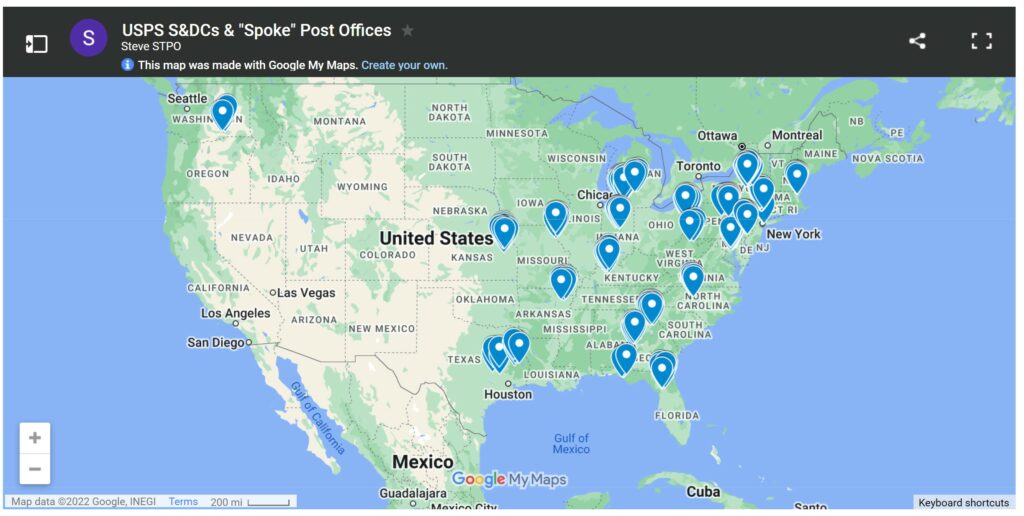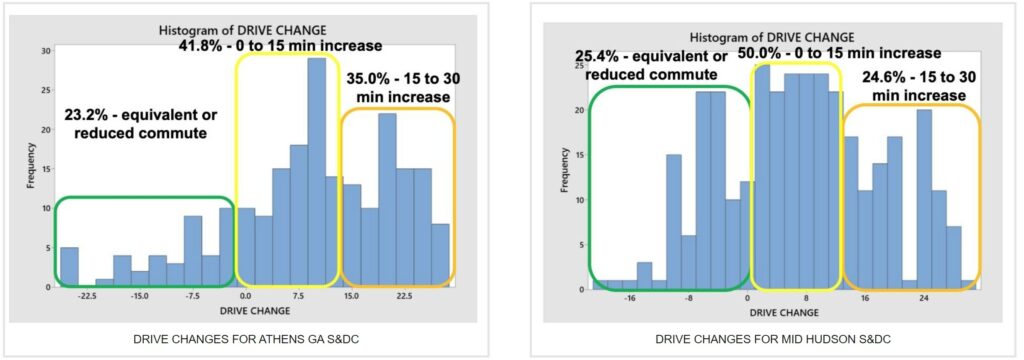Save The Post Office Steve Hutkins and Mark Jamison (retired NC postmaster) have been writing about the USPS for a long time now (years). This post is about Louis DeJoy’s efforts to centralize the Post Office into hubs with carriers leaving from the hubs and having local post offices becoming little more than retail outlets. Thereby making it more complex. His time of being removed for his office is fast approaching. Biden will be able to replace two board members whose appointment times have ended. While Amazon is figuring out how reduce miles driven, the USPS is redesigning its delivery network to add more miles: 700 million additional miles annually. This post is to explain what Postmaster Louis DeJoy is up to in rearranging the Post
Topics:
run75441 considers the following as important: Hot Topics, law, Louis Dejoy, politics, US Post Office
This could be interesting, too:
Robert Skidelsky writes Lord Skidelsky to ask His Majesty’s Government what is their policy with regard to the Ukraine war following the new policy of the government of the United States of America.
NewDealdemocrat writes JOLTS revisions from Yesterday’s Report
Joel Eissenberg writes No Invading Allies Act
Ken Melvin writes A Developed Taste
Steve Hutkins and Mark Jamison (retired NC postmaster) have been writing about the USPS for a long time now (years). This post is about Louis DeJoy’s efforts to centralize the Post Office into hubs with carriers leaving from the hubs and having local post offices becoming little more than retail outlets. Thereby making it more complex. His time of being removed for his office is fast approaching. Biden will be able to replace two board members whose appointment times have ended.
While Amazon is figuring out how reduce miles driven, the USPS is redesigning its delivery network to add more miles: 700 million additional miles annually.
This post is to explain what Postmaster Louis DeJoy is up to in rearranging the Post Office. And there is no cost-save to this . . . only greater expense.
~~~~~~~~
Congress and the Biden administration have been very good to the Postal Service: $10 billion in emergency pandemic relief, nearly $50 billion to fix the problems caused by the retiree healthcare benefit mandate, and $3 billion for electric vehicles. You’d think everything would be good for a while and we could stop hearing about the existential crisis facing the Postal Service.
Instead, the Postmaster General continues to call for drastic measures. His Delivering for America plan has already slowed down First Class mail and raised prices across the board, and it will eventually include reducing retail hours, closing post offices, and disposing of historic properties. The PMG is also talking about eliminating 50,000 jobs.
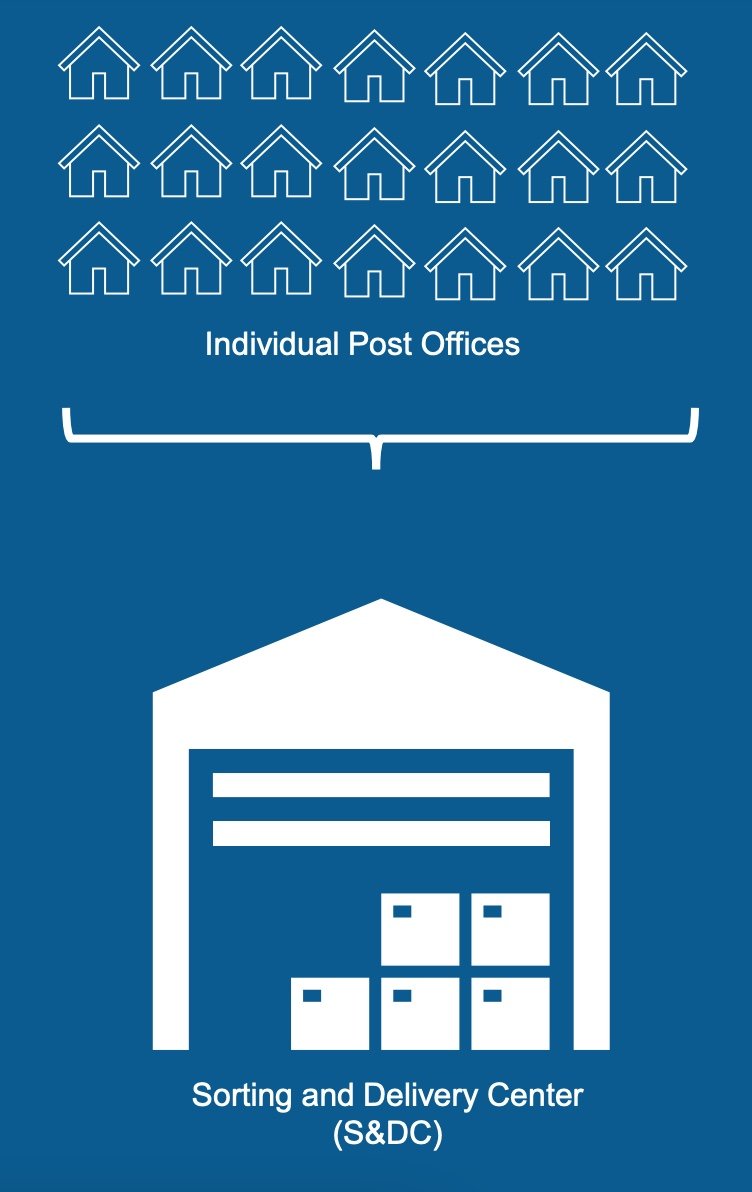
But before he gets around to cutting jobs and degrading the retail network, the Postmaster General wants to completely transform the delivery network. Next month he will begin moving letter carriers from the back of post offices to large facilities called Sorting & Delivery Centers. This promises to be the most massive change in postal operations in decades.
Rather than cutting expenses, this element of the DFA plan will actually run up delivery costs – to the tune of $2 billion a year, $16 billion over the remaining eight years of the 10-year plan. Much of the financial relief Biden and Congress have provided will be for naught, and the changes in the delivery network will ensure that more cost cutting is necessary. The plan is a bad deal for postal workers and for the country as a whole, and the Postal Service has not been straight with stakeholders, employees, and the public about what the consequences will be.
The plan, it’s important to note, has not been reviewed by the Postal Regulatory Commission, apparently because the Postal Service believes it involves operational matters outside the scope of the PRC’s Advisory Opinion process. Nor has the Office of Inspector General reviewed the plan, perhaps because there’s nothing to audit yet. If the Postal Service has asked a consulting company to review the plan, it has not made the study public.
Before getting into the weeds on what the new delivery network entails, consider what’s in store for individual letter carriers. For most of them, their new workplace at the S&DC will require a longer commute than the post office where they currently work — probably about 10 extra miles, another 15 minutes of driving time each way. That’s 2.5 hours more each week, 120 hours more a year — the equivalent of three weeks’ work, unpaid. Over the course of a year, the carrier will drive 5,000 more miles than the current commute requires. Figured at the IRS mileage rate of 63 cents per mile for gas, maintenance, etc., the increased cost would be $3,150 (non-reimbursable).
The National Association of Letter Carriers may like the idea of 10,000 new members — a likely outcome of the new delivery network — but letter carriers themselves may feel differently.
Decoupling the Post Office
For more than 150 years, post offices have provided retail services at the front of the building and housed letter carriers in the back, where the mail is prepared for delivery routes. The Postmaster General wants to “decouple” these operations. A hundred thousand carrier routes will be transferred from several thousand post offices to a few hundred Sorting & Delivery Centers.
The idea of decoupling retail and delivery operations was the subject of a 2011 OIG study and 2012 follow-up, which envisioned relocating 104,000 carrier routes at 9,600 post offices to other nearby post offices. The OIG suggested that by separating the functions delivery would be more efficient and retail could be more responsive to customers.
When I first read the IG’s report back in 2011, I thought it was a terrible idea and would inevitably lead to post office closures, more outsourcing, and privatization, as discussed in this post. When a post office loses its carriers, it also loses one of its main reasons for being there. The Postal Service uses the excess space in the back of the building to justify various modes of downsizing and dismantling: reduced operating hours, relocations to smaller spaces in shopping centers, conversions to contract offices, suspensions over lease issues, property disposals, and, of course, closures. We saw all this in 2011-2015, when the Postal Service did a Delivery Unit Optimization (DUO) initiative that relocated carriers from about 2700 post offices. The OIG did not find much in the way of cost savings, and the Postal Service has never made a post-implementation audit available to the public, if it ever even did one.
The Delivering for America plan is even worse than what the OIG proposed in 2011. It doesn’t just empty 10,000 post offices of a crucial function. It also relocates carriers to centralized facilities much further away than the nearby post office where the OIG had imagined them going. These extra miles are the plan’s fatal flaw.
A Massive Redesign
The Postmaster General introduced the concept for his new delivery plan in a snazzy presentation at the Postal Forum in May. Animated graphics contrasted the overly complex current system with the new simplified system he would be implementing.
More about the network delivery plan was made public in an article in the USPS Eagle Magazine, which was previewed back in July. It describes a “massive redesign of the postal processing, transportation, and delivery infrastructure,” including a “systematic replacement of many existing facilities.” The Eagle also provided these details: “Over the coming decade — and starting in 2022 — the Postal Service will establish a redesigned operational model that will touch almost 500 network mail processing locations; 10,000 delivery units; 1,000 transfer hubs; and almost 100,000 carrier routes. The new footprint of facilities and connective transportation will be greatly simplified, resulting in a modern network of much larger facilities with fewer, fuller trips between them.”
In comments made at a forum sponsored by AEI on July 27, the Postmaster General provided a few more details. Explaining that the Postal Service “will be aggregating much of our carrier base into larger properly equipped and strategically located sort and delivery centers,” he indicated that 19,000 carrier units would be reduced to 12,000 or 13,000 by consolidating them into bigger facilities. In other words, 6,000 or 7,000 post offices would lose their carriers. The Postmaster General also revealed something he hadn’t mentioned previously: “To get to break even I think we may need to get 50,000 people out of the organization.”
Beyond these descriptions of the plan, the Postal Service had not shared much about the changes to the delivery network — until last week, when two documents that had been shared with postal workers unions and the postmasters association became public.
Hubs & Spokes
The first document is a Power Point presentation entitled Sorting & Delivery Center (S&DC). It’s dated July 29, 2022, and may have been shared by the Deputy Postmaster General (“dpmg” appears in the URL). It begins with a few bullet points about the objectives of the plan: “improved customer service,” “easier standardization and management of operations,” and more “efficiencies in transportation and mail handling.” It then provides details about ten of the S&DCs and what it calls their “spoke facilities,” i.e., the post offices from which carriers will be relocated.
The presentation indicates that ten S&DCs would absorb 1,460 routes from 150 spoke offices. It also shows modeling for two Metro area conversions: Indianapolis, where two S&DCs would absorb 1,058 routes from 35 post offices, and Atlanta, where 8 S&DCs would take 2,327 carriers from 73 post offices. There’s also a brief description of a few offices sending carriers to Brooklyn’s Alabama S&DC to show how a foot/parcel route would work out.
The presentation has several tables listing the post offices that would lose their carriers, the number of routes for each of them, and the one-way travel distances in miles and minutes. For example, here’s the table for the Athens GA S&DC.

SOURCE: USPS PRESENTATION 7/29/22
The presentation also offers projections for how many new routes will be necessary as a result of the longer travel distances. As these tables indicate, the number of routes would increase by 5 to 10 percent. With 100,000 routes being impacted, that’s 5,000 to 10,000 new routes.

Under the current delivery network, contract trucks carry the mail early each morning from processing and distribution centers (P&DCs) to delivery units (DUs) at the post office. The contract trucks go from one post office to the next, like going around a circle with the P&DC in the center. Here’s an imaginary visualization (not from the presentation) of two truck routes going to the 13 post offices that would send their carriers to the Athens GA S&DC. The two truck routes add up to about 150 miles.
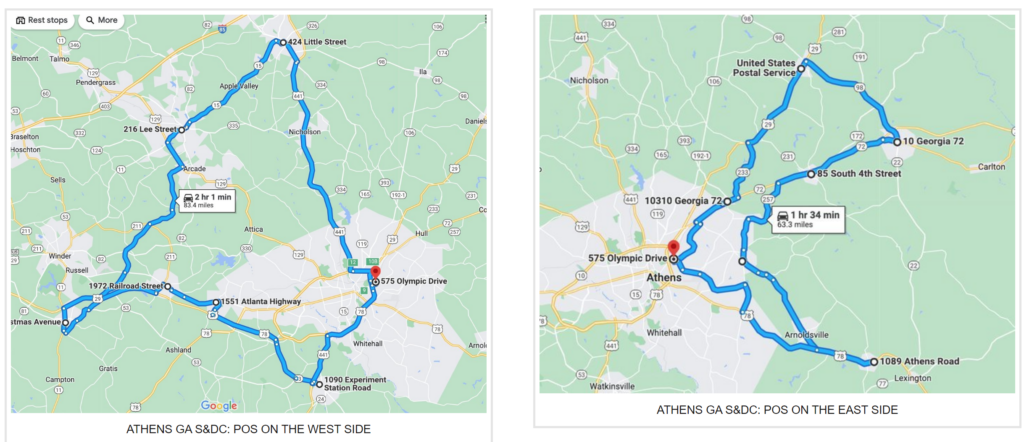
In the new system, the S&DC becomes a “hub,” and the post offices become “spoke facilities.” Here’s a diagram of the Athens GA hub and spoke from the July 29th presentation, along with a Google map version. The 13 post offices have 103 routes, which add up to about 1,600 miles — ten times the two truck routes — to get to the same goal.
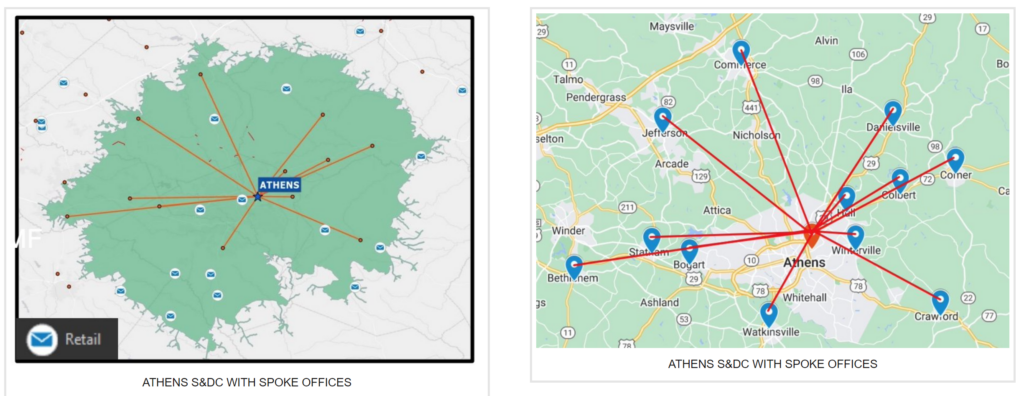
Needless to say . . . , the presentation does not make this contrast or say anything about how the current system might be more rational in how it gets mail from processing centers to addresses.
A second document, dated August 12, 2022, which is presumably a more up-to-date picture of the plan, shows 21 S&DCs and 205 post offices where carrier “conversions” will take place. (Three S&DCs that were on the 7/29/22 list do not appear on the 8/12/22 list — Mid Hudson NY, Columbus GA, and Southeastern PA — as well Indianapolis and Atlanta.)
The second list indicates that the implementation will begin with the Athens GA consolidations by September 24; the Brooklyn in November, and the remainder of the 205 by February 2023. This document does not provide any data about routes and distances, but such information is not hard to come by.
Lists & Maps
By combining the two lists and filling in the missing data points for number of routes (using the EDDM web page) and distances and drive times between post offices and S&DCs (using Google maps), one can cobble together a list of 33 S&DCs and the post offices that would lose their carriers. To the extent that this list is a representative sample, it provides a picture of what full implementation might look like.
Below is a list of 24 of the S&DCs and their post offices. It does not include the two metro areas because the 7/29/22 list did not provide them. This list is on Google Drive here. Note that this is not an official USPS list and it may have errors with respect to the address and other details.
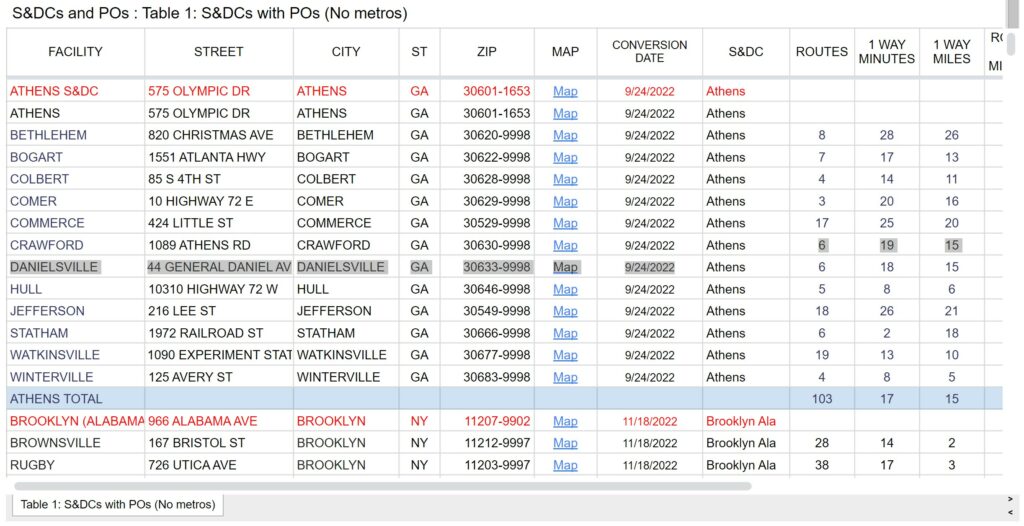
Map of the S&DCs based on this table. If you zoom in, you’ll see the individual post offices and the S&DC, marked in red.
Below is a list that summarizes the data on the previous list, along with the data on the two metro areas. (It’s on Google Drive, tab “Table 2: S&DC totals.”) It shows the number of facilities and routes for each S&DC, the average distance in miles and minutes between the S&DCs and its spoke facilities, and the work hours represented by the additional drive time.

As this table shows, some S&DCs would be relatively small, with 20 or 30 carriers from 5 or 10 post offices, while others would be quite large, housing 400 to 500 carriers relocated from 20 to 25 post offices.
Some of these S&DCs would be co-housed in one of the 350 Processing & Distribution Centers (P&DCs) or another processing facility; in some cases, a P&DC might be converted to a S&DC. The Postal Service is also planning to build some large new S&DCs, like those in Atlanta and Indianapolis, and it has many other types of facilities that could be used for S&DCs, including large post offices.
Adding up the Costs
Below is a table summarizing the data for the 33 S&DCs on the two lists, as derived from the data in the previous list, along with calculations that extrapolate to the full implementation of the plan with 100,000 routes. (The calculations simply multiply the numbers for the shared list by 18, the factor to get from 5,545 to 100,000.)

NB: THESE NUMBERS ARE BASED ON USPS LISTS, BUT THEY ARE NOT OFFICIAL USPS CALCULATIONS
As these projections show, there might eventually be about 600 S&DCs. (The 7/29/22 presentation states that the Postal Service has already identified 928 existing facilities with available space and site surveys have been initiated.) On average, a S&DC would serve an average of 170 carrier routes (approx. 200 carriers) relocated from 11 “spoke” post offices.
The total number of work hours could increase by over 18 million, which translates to about 8,800 additional routes, an increase of 8.8 percent. As noted above, the 7/29/22 presentation indicated that the number of routes would increase by 5 to 10 percent, so an increase of 8.8 percent would not be surprising.
With 6-day delivery, vacation days, etc., it takes more than one carrier to cover a route — there are about 233,000 routes and 330,000 carriers – so these additional 8.800 routes could represent an increase of as many as 10,000 carriers.
The plan would increase delivery costs dramatically. To pay for the carriers needed to cover the 8,800 additional routes and the nearly 18 million additional work hours, labor costs alone could total over $750 million. And then there’s the immense cost of vehicle depreciation, maintenance, and fuel. The 2012 OIG report on “decoupling” 100,000 routes estimated cost per mile at $1.48, plus 0.20 a mile for tort costs to deal with accidents. (Not a minor consideration given that carriers will be jumping on and off highways to get to their routes. The 7/29/22 presentation shows many cases where the delivery trucks are expected to go 60 mph.)
Today’s transportation costs are probably higher than in 2012, but even using the OIG’s rates, 750 million additional miles would cost about $1.2 billion. That brings the grand total for labor and travel to nearly $2 billion.
If that seems like an unreasonably high projection, consider this: The OIG report figured that the average distance between the post office and first stop on the route was about 2.8 miles; with a consolidation, the average would increase to about 5 miles. This additional 2.2 miles for 100,000 routes led to increase costs for labor and vehicles of $377 million. Under the DFA plan, the average distance would increase by about 13 miles. That’s six times what the OIG envisioned, so it would not be surprising if the costs were several times greater as well.
Commuting costs
In addition to the increased costs for the Postal Service, there’s the added burden placed on carriers who’ll have longer commutes. The 7/29/22 presentation considers this issue by providing some data for a few of the S&DCs. For the Athens GA S&DC, for example, the median commuting time would go from 16 minutes to 27 minutes, an increase of 11 minutes (about 8 miles). For Mid Hudson NY, the median increase would be the same. For Bryan TX, employees apparently live close to the P&DC: the median increases from 13 to 16 minutes. The presentation provides these graphics to illustrate the drive changes.
For some reason, the presentation uses median rather than mean averages, which may be helpful but don’t provide a full picture. If you dig into the charts, you’ll find that the means are somewhat larger than the medians. The average commute will probably increase by about 10 miles and 15 minutes each way.
For 100,000 routes, that adds up to 15 million hours annually — hours for which the Postal Service won’t be paying wages. It also adds up to about 600 million miles annually, and again, the burden is all on employees.
That 600 million miles is top of the 700 million more miles added to the routes themselves. In total, the plan could add 1.3 billion miles of driving annually. It’s hard to imagine how this complies with President Biden’s goals for reducing greenhouse gas pollution, even if many of the new postal trucks are electric vehicles.
And the Cost Savings?
According to the OIG study, even though the longer distances would increase expenses, there would be opportunities for reducing costs. Clerks at post offices not only do retail work; they also help load and unload trucks and provide other forms of delivery support labor. The OIG also notes that without carriers to supervise, postmasters and station managers would have their supervisory levels reduced, and this too would cut costs.
For the 100,000 route consolidations in its plan, the OIG estimated a reduction of 13.6 million support labor hours, which would come to about 6,500 positions and $566 million in costs. Presumably these cost savings would also happen with the DFA plan. Not surprisingly, the APWU is already threatening to challenge the plan as a violation of its contract, and the postmasters association is talking about early retirement and finding “new landing spots for impacted personnel.”
The OIG report imagined carriers moving to other nearby post offices, not centralizing them in large S&DCs. This new approach could also allow for other savings, such as cutting down on the contract trucks that take mail from the processing centers to the delivery units. (This is called infra-SCF transportation.) Reducing dependence on such outsourcing could be a good idea (ironic, too, since trucking for the Postal Service helped the Postmaster General make his fortune), but how much could the plan save?
Once the S&DC plan is implemented, there would still be about 12,000 or 13,000 post offices with delivery units and another 12,000 with PO boxes, all requiring daily delivery from a processing center. Who’s going to make the daily deliveries to these facilities? It’s possible that carriers from the S&DCs could do this, but that would add many more stops to their routes and necessitate even more routes. Plus, many post offices are well outside the 30-minute reach of an S&DC, so carriers won’t be in the vicinity to handle those deliveries. Overall, it’s hard to imagine that the new system will completely eliminate the need for contract trucking to post offices.
There could be other efficiencies as well, such as preparing the mail for loading trucks at the S&DCs. If this operation is conducted for two or three hundred carriers each morning, it might be done in ways that are more cost efficient than doing it at the post office. So perhaps some clerk and mail handler jobs could be eliminated that way. But it sounds as if the current processing centers will have plenty of work to do when they’re also functioning as S&DCs, so one wonders how many positions might be eliminated besides the 6,500 eliminated at post offices, already accounted for above.
The Postmaster General told the AEI forum that he plans to shed 50,000 positions over the next few years. If letter carriers increase by 10,000, we might be looking at 60,000 cuts in other areas. Some would come from the processing network, but the only other place to look for significant reductions is post offices.
Space Costs
The OIG decoupling report suggests that $817 million could be saved in what it describes as “space costs,” and it contains a detailed analysis of how much space a carrier needs. It says that current operations provide about 366 square feet per carrier, but only 130 to 180 square feet are necessary. But reducing floor space doesn’t mean much if the post office that loses its carriers remains just as it was before. That extra space in the back isn’t saving any money.
As it turns out, the OIG’s savings for space costs involves closing post offices. One has to dig around in the report to learn this, like in a footnote that says, “This analysis assumes retail units in closed delivery facilities are also closed.” Or buried in another paragraph: “The model assumes that retail services in closed delivery units can transition to other existing retail units.” In fact, in order to save $817 million, the model assumes that all 10,000 post offices will be closed.
The Delivering for America plan does indicate that post office closings and reductions in operating hours are on the horizon. At one point it says, “Evaluate and consolidate low-traffic stations and branches of city Post Offices into nearby full-service retail Post Offices.” And at another, it says “rationalizing stations and branches” and “optimizing” hours at post offices could save $3 to $4 billion over ten years. That’s a lot of hours to “optimize” and a lot of post offices to “rationalize.” As for how many, the Postmaster General has only said it would be a “small number.”
Which Post Offices?
The Postal Service has obviously not provided a list of the six or seven thousand post offices that could lose their carriers, but one can get some idea of which are at risk.
If there are going to be about 600 S&DCs, most of the 350 Processing & Distribution Centers will probably house one. A list of those P&DCs, along with 30 other processing facilities of various types, is here. A map is here.
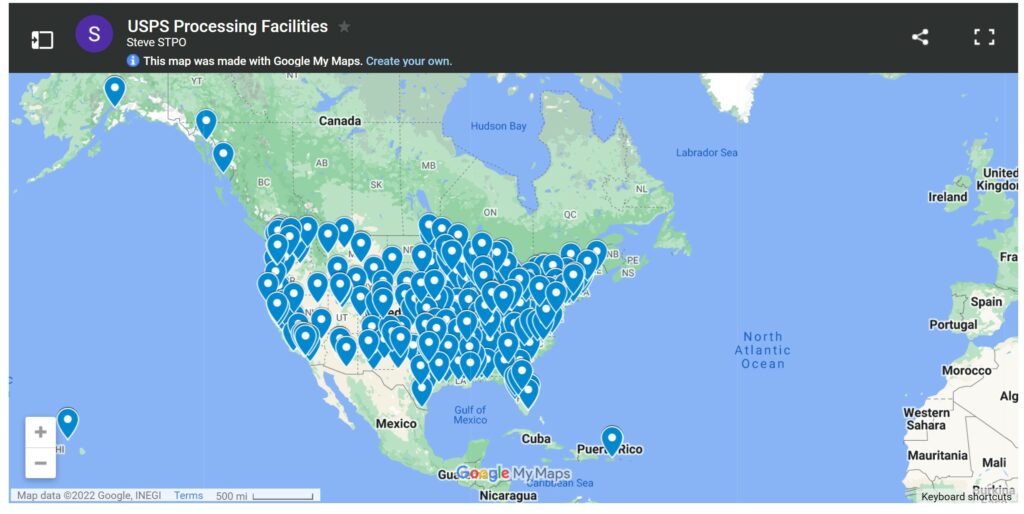
If you click on a “Map” link in this list or on the map’s pop-up, you’ll go to a new map showing the processing center. Search the “Nearby” field for “post offices,” and Google will show the nearest postal facilities. Most likely, 12 to 15 of these post offices will have carrier units.
Google won’t tell you the facility type, but you can check this list of postal facilities from the USPS PostalPro website. If it’s a Main Post Office, Administrative Post Office (APO), Station, or Branch, it’s probably one of the 19,000 facilities that have delivery units. And if it’s reasonably close to a P&DC, it’s a good bet it would eventually lose its carriers. If it’s a Remotely Managed Post Office (RMPO), i.e., those that had their hours cut under POStPlan, it probably doesn’t have carriers. If it’s a finance unit (a Finance Station or Finance Branch), it may or may not have carriers.
This method is far from perfect, but for now, it’s about the only way to anticipate which post offices are most at risk of losing their carriers. We’ll take a closer look at the post offices at risk next time around.
Introducing the New USPS Sorting & Delivery Centers – Save the Post Office, Steve Hutkins, August 30, 2022


